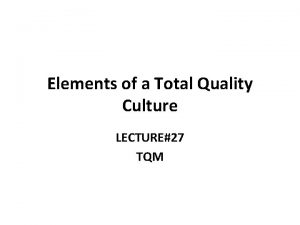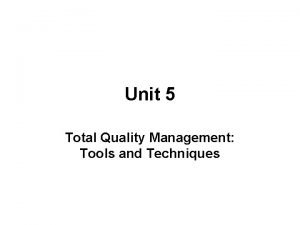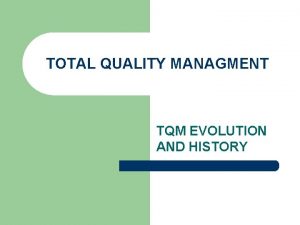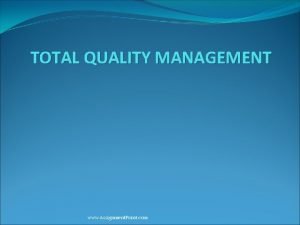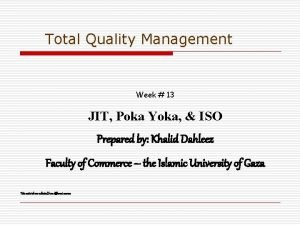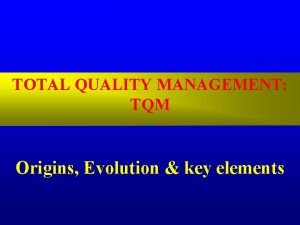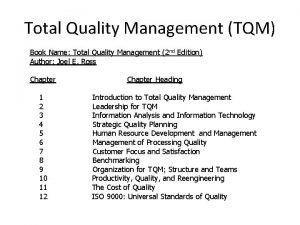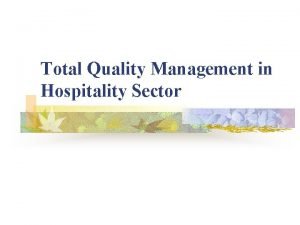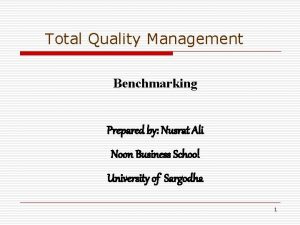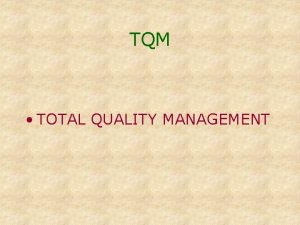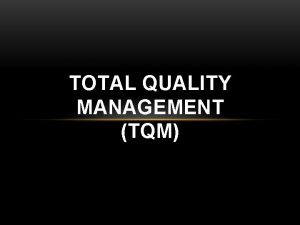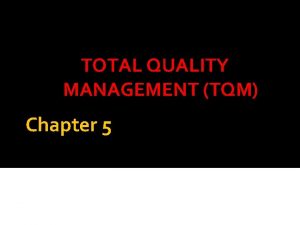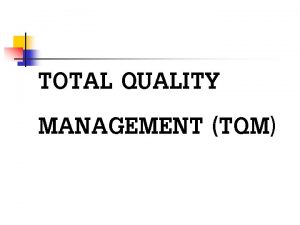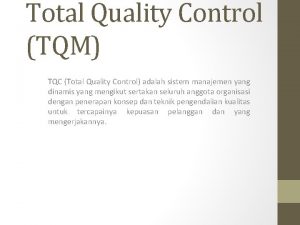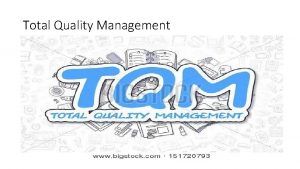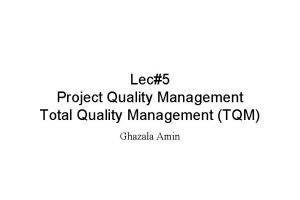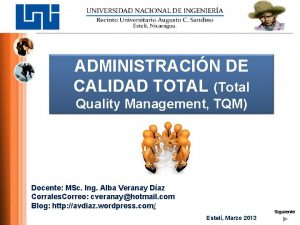TOTAL QUALITY MANAGEMENT TQM Chapter 5 Prepared customized














- Slides: 14

TOTAL QUALITY MANAGEMENT (TQM) Chapter 5 Prepared & customized by : Dr. Ali Zahrawi ali. zahrawi@khawarizmi. com 1

Total Quality Management (TQM) • Total - made up of the whole • Quality - degree of excellence a product or service provides • Management - act, art or manner of planning, controlling, directing, …. Therefore, TQM is the art of managing the whole to achieve excellence CHAPTER 5 -- Total Quality Management 2

What does TQM mean? • Total Quality Management means that the organization's culture is defined by and supports the constant attainment of customer satisfaction through an integrated system of tools, techniques, and training. • This involves the continuous improvement of organizational processes, resulting in high quality products and services. CHAPTER 5 -- Total Quality Management 3

What’s the goal of TQM? “Do the right things right the first time, every time. ” TQM is all managers leading and facilitating all contributors in everyone’s two main objectives: (1) total client satisfaction through quality products and services; and (2) continuous improvements to processes, systems, people, suppliers, partners, products, and services. CHAPTER 5 -- Total Quality Management 4

Basic Beliefs of TQM 1. The customer makes the ultimate determination of quality. 2. Top management must provide leadership and support for all quality initiatives. 3. Preventing variability is the key to producing high quality. 4. Quality goals are a moving target, thereby requiring a commitment toward continuous improvement. 5. Improving quality requires the establishment of effective metrics. We must speak with data and facts not just opinions. CHAPTER 5 -- Total Quality Management 5

The three aspects of TQM Counting Customers Culture Tools, techniques, and training in their use for analyzing, understanding, and solving quality problems Quality for the customer as a driving force and central concern. Shared values and beliefs, expressed by leaders, that define and support quality. CHAPTER 5 -- Total Quality Management 6

Modern History of Quality Management • Frederick W. Taylor wrote Principles of Scientific Management in 1911. • Walter A. Shewhart used statistics in quality control and inspection, and showed that productivity improves when variation is reduced (1924); wrote Economic Control of Manufactured Product in 1931. • W. Edwards Deming and Joseph M. Juran, students of Shewhart, went to Japan in 1950; began transformation from “shoddy” to “world class” goods. • In 1960, Dr. K. Ishikawa formalized “quality circles” - the use of small groups to eliminate variation and improve processes. • In the late ‘ 70’s and early ‘ 80’s: – Deming returned from Japan to write Out of the Crisis, and began his famous 4 -day seminars in the United States – Phil Crosby wrote Quality is Free – NBC ran “If Japan can do it, why can’t we? ” – Motorola began 6 Sigma CHAPTER 5 -- Total Quality Management 7

Deming’s 14 Points* 1. Create constancy of purpose for improvement 2. Adopt a new philosophy 3. Cease dependence on mass inspection 4. Do not award business on price alone 5. Work continually on the system of production and service 6. Institute modern methods of training 7. Institute modern methods of supervision of workers 8. Drive out fear 9. Break down barriers between departments 10. Eliminate slogans, exhortations, and targets for the work force 11. Eliminate numerical quotas 12. Remove barriers preventing pride of workmanship 13. Institute a vigorous program of education and retraining 14. Take action to accomplish the transformation CHAPTER 5 -- Total Quality Management 8

The Deming Cycle or PDCA Cycle PLAN Plan a change to the process. Predict the effect this change will have and plan how the effects will be measured DO Implement the change on a small scale and measure the effects ACT Adopt the change as a permanent modification to the process, or abandon it. CHECK Study the results to learn what effect the change had, if any. CHAPTER 5 -- Total Quality Management 9

Elements for Success • • • Management Support Mission Statement Proper Planning Customer and Bottom Line Focus Measurement Empowerment Teamwork/Effective Meetings Continuous Process Improvement Dedicated Resources CHAPTER 5 -- Total Quality Management 10

Total Quality Management and Continuous Improvement • TQM is the management process used to make continuous improvements to all functions. • TQM represents an ongoing, continuous commitment to improvement. • The foundation of total quality is a management philosophy that supports meeting customer requirements through continuous improvement. CHAPTER 5 -- Total Quality Management 11

Continuous Improvement versus Traditional Approach Continuous Improvement • Market-share focus • Customer focus • Individuals • Cross-functional teams • Focus on ‘who” and “why” • Focus on “what” and “how” • Short-term focus • Long-term focus • Status quo focus • Continuous improvement • Product focus • Process improvement focus • Innovation • Incremental improvements • Fire fighting • Problem solving CHAPTER 5 -- Total Quality Management 12

The Continuous Improvement Process Measurement Empowerment/ Customer Satisfaction Business Results Team Management Process Improvement/ Problem Solving Measurement Shared Leadership . . . Measurement CHAPTER 5 -- Total Quality Management 13

Value-based Approach • Manufacturing Dimensions • Service Dimensions – Performance – Features – Reliability – Conformance – Durability – Serviceability – Aesthetics – Perceived quality – Reliability – Responsiveness – Assurance – Empathy – Tangibles CHAPTER 5 -- Total Quality Management 14
 Contemporary
Contemporary What is tqm
What is tqm Gurus of total quality management
Gurus of total quality management Quality culture in tqm
Quality culture in tqm Tqm tools and techniques
Tqm tools and techniques History of quality management evolution
History of quality management evolution Definisi tqm
Definisi tqm Total quality management system
Total quality management system Tqm summary
Tqm summary Inventor of quality management
Inventor of quality management Pengertian total quality management
Pengertian total quality management Tqm book
Tqm book Tqm in hospitality industry
Tqm in hospitality industry Benchmarking in total quality management
Benchmarking in total quality management Quality assurance cycle in nursing
Quality assurance cycle in nursing



